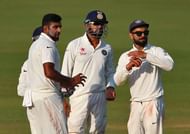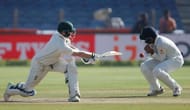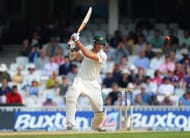In the recently concluded first Test of the Border-Gavaskar Trophy, Australia humbled India by 333 runs. Going by India’s form this home season and the dustbowl that was on display at the MCA stadium, India were billed the pre-match favourites. However, in a game that lasted a little less than 3 days, the Australians outdid their Indian counterparts in every department of the game.
More than the defeat, it was the manner of the defeat that has raised several questions. Going into the second Test of this 4-match series, Australia have surely managed to wrestle the momentum away from India.
With the Bengaluru Test only a few days away, we take a look at the five things that India must do to make a comeback in this series:
#1 Get a solid opening partnership
There is no doubt that both KL Rahul and Murali Vijay are excellent batsmen. However, the duo have not quite hit the ground running as India’s opening pair. In 13 innings together, the two right-handers have aggregated a mere 259 runs at a paltry average of 19.92.
In fact, there’s been only one instance when the two have managed to share an opening alliance of more than 50.
The failure of the Rahul-Vijay duo has meant that the rest of the Indian batsmen have been left with a lot to do. While the Indian batting did come out trumps in the games against New Zealand and England, Australia is a completely different ball game given the potency and the variety of their attack.
It would do the Indian team a world of good if these two could start stitching some big partnerships at the top of the order.
#2 Make better use of the DRS
The BCCI acceded to the use of the Decision Review System (DRS) in bilateral series’ only recently. In the 7 Tests featuring the Indian team thereafter, India have opted for a review on 55 occasions. With a success percentage of 30.90%, 17 of these reviews have been successful. However, a closer look at these numbers reveals an anomaly. The aforementioned 55 reviews consist of 13 batting reviews, of which 7 are correct.
When it comes to fielding reviews, the Indian team have had a hard time with the DRS. Only 10 of their 42 fielding reviews have been successful. In fact, in the Pune Test, all four of India’s fielding reviews were unsuccessful. Two of these came off consecutive overs in Australia’s second innings. By the time Steve Smith was wrongly adjudged not out in the 56th over of the innings, India had run out of reviews.
The batsmen too were guilty of misusing the DRS as both of India’s reviews had been wasted by their opening batsmen before the 6th over of the second innings. Based on the evidence of their DRS usage, India surely need to start using the technology a lot more judiciously.
#3 Improve their catching
In the recently concluded Test series versus England, one of the facets of India’s game that went unnoticed was their poor catching. In that series, the Indian fielders were guilty of dropping as many as 20 catches, most of them in close-in areas. The stupendous form of both their batsmen and their bowlers meant that they didn’t really have to pay a heavy price for it and they won the series comfortably.
However, in the first Test, India’s fielding inefficiencies cost them dear as they failed to latch on to their chances at crucial junctures. In Australia’s second innings, Steve Smith was the beneficiary of India’s buttery fingers on 3 occasions as he capitalised on them to slam a match winning ton.
Matt Renshaw too lived a charmed life courtesy of the Indian fielders’ generosity. An age old adage in cricket says, ”Catches win matches” and India will have to hold on to the catches that come their way to make a comeback in the series.
#4 Get Steve Smith early
Dish out an Indian bowling attack and Steve Smith will absolutely devour it. In seven games played against India, the Australian captain has amassed more than a 1,000 runs at a staggering average of 88.83. In the process, he has racked up five hundreds and three fifties with a best score of 192.
To go with these impressive numbers, Smith will be bouyed by the fact that he managed to get a hundred on a rank turner against arguably two of the best spinners in world cricket at present.
It is not that the 27-year old is invincible. There are certain chinks in his armour that the Indian bowlers should look to exploit. For instance, he struggles against the moving ball, especially when it is pitched up outside the off-stump. This was a tactic that the English bowlers used to great effect during the 2015 Ashes.
Though India do not have the kind of seaming conditions that prevail in England, they do have bowlers like Umesh Yadav and Bhuvneshwar Kumar who can move the ball both ways. In short, the Indian bowlers will have to find a way to tame their nemesis or else they run the risk of one man taking the series away from them.
#5 Mop up the tail
In the final session of the first day’s play at the MCA stadium, the Indian bowlers were on the rampage. From a decent looking score 152/4 at tea, the Australians were reduced to 205/9. Just when it seemed that the Indian innings wasn’t too far away, the hosts ran into a gritty Mitchell Starc and his boundary-wielding willow.
In the next 12 overs, he smashed the Indian bowlers to all parts of the ground and ensured that the visitors finished the day unbeaten at 255/9.
While there is no doubt that Starc’s boundary-studded innings propelled the Aussies to an eventual score of 260, what is really worrying is the fact that the Indian bowlers couldn’t get Josh Hazlewood(Australia’s number 11) out even after bowling 31 deliveries at him. An almost similar story panned out in the second innings as Starc sparkled with another cameo.
The last three Australian batsmen kept the Indian attack, consisting of the two top-ranked bowlers in test cricket, at bay for a little more than 12 overs. Though it is true that the Australians bat deep, the Indian bowlers will have to be equal to the task to prevent matches slipping away from their grasp.
Follow IPL Auction 2025 Live Updates, News & Biddings at Sportskeeda. Get the fastest updates on Mega-Auction and cricket news





